Applicable Models: 2000-’05 MPV
On some vehicles, the output air temperature may differ between the two center dash air vents (vents on either side of audio system). This condition usually occurs when the HVAC settings are in the following positions: A/C switch ON, in BI-LEVEL or VENT mode, Temperature Control Dial in 1 o’clock to 3 o’clock position (set for warm air).
Customers with this concern should have their vehicle repaired using the following repair procedure.
Repair Procedure: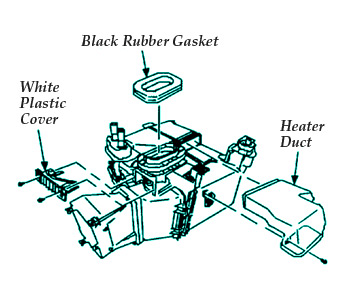
Using the service “plate” and modifying the HVAC cool-ing/heating unit will decrease the output air temperature difference between the center dash vents.
1. Verify customer concern.
2. Record the customer’s pre-set radio stations.
3. Remove the dashboard/cooling unit according to the MPV Workshop Manual (Section 07-11) Front A/C Unit Removal/Installation.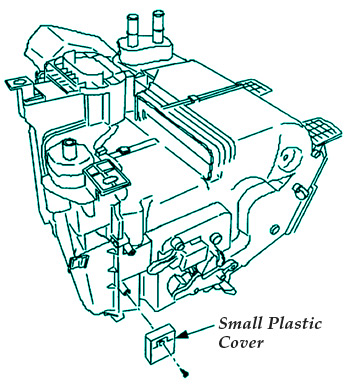
Front A/C Cooling Unit Modification:
1. Set the cooling unit on a work bench with the heater pipes pointing upward and the white heater duct facing toward you as shown in Fig. 1.
2. Remove the screw holding the heater duct to the cooling unit, then remove the duct.
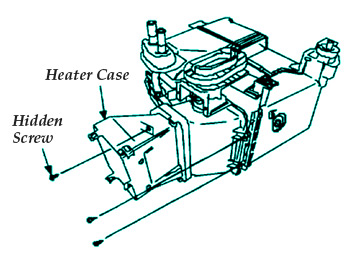 3. Carefully remove the black rubber gasket by peeling it off from the cooling unit.
3. Carefully remove the black rubber gasket by peeling it off from the cooling unit.
Note: The gasket will need to be reused. Do not allow any dirt or debris to contact the gasket adhesive.
4. Remove the two screws holding the white plastic cover near the expansion valve, then remove the cover.
5. Remove the screw holding the small white plastic cover found on the opposite side, then remove the cover according to Fig. 2.
6. Remove the three screws holding the heater case, then remove the heater case according to Fig. 3.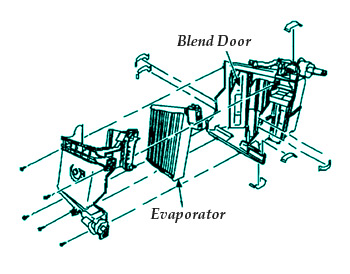
7. Position the A/C cooling unit to remove the five screws and seven small clips holding the front evaporator cover according to Fig. 4.
8. Pull off the evaporator cover.
9. Remove the evaporator from the cooling unit and carefully set it aside to prevent any damage to the evaporator cooling fins.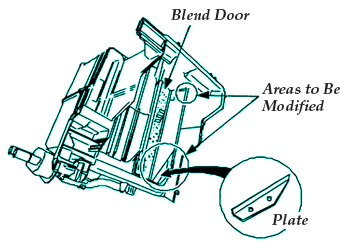
10. Prepare to install the “plate” and modify the “case rib” area shown in Fig. 5.
11. Place shop rags under the blend door area.
12. Close the blend door and position plate so there is a 2 mm gap between the blend door and plate when the blend door is closed as shown in Fig. 6.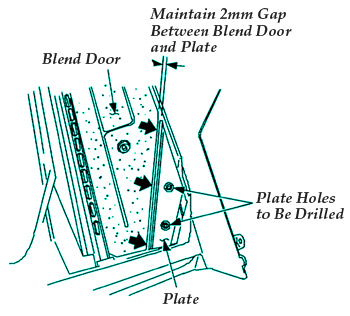
13. Using the plate as a template, hold it in position and mark the two holes for drilling. Warning: Be sure to wear safety glasses before drilling.
14. Drill two holes using a 5/32” drill bit.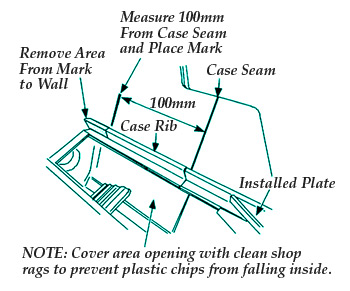
15. Attach the plate to the cooling unit case with two 5/32” pop rivets with 13 mm “grip range.”
16. Move the blend door back and forth to ensure the door is not binding on the plate.
17. Using a dremel tool, die grinder or hot knife, remove only the “shaded” portion of the case rib as shown in Fig. 7.
18. Remove the case rib portion and shop rags.
19. Remove all plastic debris from under the blend door and inside the cooling unit with compressed air.
20. Re-assemble the cooling unit in reverse order.
21. Re-install the cooling unit and dashboard assembly in the reverse order of removal.
22. Re-charge the A/C system and confirm that all dashboard and HVAC controls operate properly.
23. Re-enter customer’s pre-set radio stations.
24. Verify the repair.
Courtesy of ALLDATA.











